
![]()
Search the Journey to Forever website – click HERE
|
Journey to Forever: Make a donation |
Navigation
Contact usTo Keith Addison Handmade Projects |
City farms
City farming is spreading fast -- it was estimated in 1993 that city farms were contributing 15% to world food production and it was expected to grow to 33% by 2005. According to the UNDP, some 800 million people worldwide were involved in urban agriculture in 1996, growing fruits, vegetables, and herbs, as well as raising livestock. Cities cover only 2% of the Earth's surface, but consume 75% of its resources. Cities are black holes, they're swallowing our planet. But, more and more, they're turning green. City farming is growing just as rapidly in the rich cities of the West, perhaps more because of environmental concerns, but also to feed the hungry: the Urban Agriculture Network was
-- "Ideally we believe that simply by changing from suit to jeans, digging up a bit of lawn, and planting vegetable seeds, the city person will begin asking questions about his environment and about his urban behavior and thinking patterns" -- founding directors of City Farmer, addressing science teachers at the 20th International Science Education Symposium in 1979 By 1994, 300,000 households in the US were using a community garden, and 6.7 million more said they'd do so too if there was one nearby (National Gardening Association). Journey to Forever will promote city farming and community gardening initiatives in all the urban centres we visit along our route.
More than half of the poor people in developing countries now live in urban areas, up from about a third in 1988 -- only 12 years ago -- and still increasing.
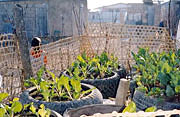
Urban farming in Haiti -- AGUILA Urban Agriculture Research Network Latin America
International Development Research Centre, Canada
Poor people in cities farm scraps of ground wherever they can grow something to provide some food and make some money -- and they save money they would have spent on food. City farming makes a hefty contribution to the fight against poverty and hunger.
It also makes a hefty contribution to environmental and public health. Every year 5.2 million people, including four million children, mostly in cities, die from diseases caused by unhygienic sewage and waste disposal,
and urban waste production is growing even faster than urban populations: by the year 2025, urban waste production will have quadrupled from 2000.
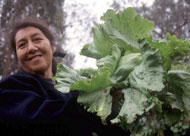
City farming in Peru (AGUILA)
City farmers play a major role in waste recycling, creating a closed system in which organic wastes -- from food, manufacturing and sewage -- are reused instead of festering in dumps and polluting waterways. Human waste is turned into compost, domestic wastewater safely irrigates many crops, and aquaculture stabilizes animal manure. In Mexico City many families keep pigs -- urban pig farmers recycle up to 4,000 tons of the city's food wastes every day.
And city farming empowers women, which benefits everyone. Women in a vegetable-growing cooperative in Bogota, Colombia, earn three times more than their husbands do.
Expansion
Jac Smit, President of the Urban Agriculture Network and co-author of "Urban Agriculture: Food, Jobs, and Sustainable Cities", paints a vision of what the world would be like if cities were nutritionally self-reliant: "As we consider a dominantly urban Earth early in the next century, in a world with less land and water per-capita, the return of agriculture to where we live presents us with a new paradigm.
"What if 'waste is food' and sewage and garbage were prime inputs to food production? What if the urban landscape were edible? What if vacant, waste land in cities were productive and enhancing the environment for living? What if urban areas were increasing biodiversity rather than diminishing it?"
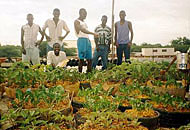
Urban farming in Haiti (AGUILA)
It's happening. Growing your own food in cities has long been the way in Asia, and it's expanding enormously in Africa, Latin America, and all over the world.
All over the world urban food production is growing more rapidly than urban population -- in spite of urban drift.
In greater Bangkok, 60% of the land is under cultivation, 72% of all urban families are engaged in raising food, mostly part-time.
In Moscow, the share of families raising food more than tripled between 1972 and 1992, from 20% to 65%.
In Dar-es-Salaam in Tanzania the number of households engaged in food production grew from 20% to more than 65% between 1970 and 1990.
In Argentina the number of participants in the community agriculture program grew from 50,000 to 550,000 between 1990 and 1994, and the number of supporting institutions grew from 100 to 1,100.
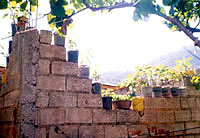
Urban farming in Haiti (AGUILA)
The area devoted to urban agriculture in Harare in Zimbabwe doubled between 1990 and 1994.
It's a true grassroots initiative of "helpless" people helping themselves. Yet they do need help, as much help as they can get -- help in learning the best and safest ways of recycling wastes and the best growing methods, and help in persuading governments and local authorities to support their efforts rather than neglecting them, or even harassing them for occupying public land or land legally zoned for urban use, not agriculture.
Industrialised nations
"founded in response to the increase of persistent hunger in urban areas in both poor countries and rich countries".

Visitors take part in horticulture therapy at City Farmer's community garden
The city farming movement has been intensely studied in the 20 years or so that it has burgeoned in the Western cities, and it has been found to deliver a rich harvest of benefits -- benefits that social workers, community organizations, educators, psychologists, health workers, nutritionists and crime fighters can only dream of where there are no city farms or community gardens.
The US government's Urban Gardening program estimates that a $1 investment in food growing projects yields $6 of produce.
Gardening for dollars, Americans go green, Reuters, Washington, May 9, 2002 -- Home gardening is huge. Chalk it up to aging boomers, post-Sept. 11 nesting, or just demand for really fresh cilantro and tomatoes; Americans will spend some $28-billion on their food and flower gardens this year, according to the National Gardening Association.
http://www.planetark.org/dailynewsstory.cfm/newsid/15878/story.htm
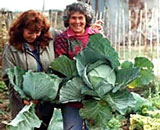 Vermiculture Improves Urban Farming in Argentina -- Impoverished citizens of Rosario, Argentina’s third largest city, are stepping up efforts to farm in urban neighbourhoods -- by using California red worms. Vermiculture (a method of composting fruit and vegetable waste using earthworms) is proving to be an inexpensive and easy way to create high-quality organic fertilizer. It is also helping improve the local environment.
Vermiculture Improves Urban Farming in Argentina -- Impoverished citizens of Rosario, Argentina’s third largest city, are stepping up efforts to farm in urban neighbourhoods -- by using California red worms. Vermiculture (a method of composting fruit and vegetable waste using earthworms) is proving to be an inexpensive and easy way to create high-quality organic fertilizer. It is also helping improve the local environment.
http://www.idrc.ca/reports/read_article_english.cfm?article_num=1087
See Vermicomposting
-- "1,631,694 files transmitted from our website for all of 1999, up 43% over 1998" -- City Farmer, Canada's Office of Urban Agriculture, January 2000
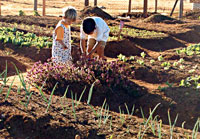
Everybody benefits, but some of the main beneficiaries are the children. Community garden in Brazilia (City Farmer)
See our Organic gardening, Container gardening and Composting pages.
Resources
City farms
Organic gardening
Building a square foot garden
Plant spacing guides
No ground? Use containers
When to sow what
Seeds
Garden pond
Gardening resources
Composting
Making compost
Composting resources
Composting indoors
Vermicomposting
Humanure
Composting for small farms
Small farms
Small farm resources
Community-supported farms
Farming with trees
Farming with animals
Pasture
Pigs for small farms
Poultry for small farms
Aquaculture for small farms
Composting for small farms
Controlling weeds and pests
Small farms library